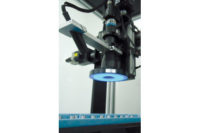
Machine vision technology is used throughout the world for in-process, automated inspection. It is found in widely varying industries to perform tasks such as gaging, assembly verification, robot guidance, optical character recognition and validation, flaw detection and code reading.
Machine vision technology has changed significantly over the years and is constantly growing and improving. Nonetheless, certain fundamentals must be understood in order to achieve successful specification and implementation of any machine vision application.
Overview
A machine vision system is a group of components that can acquire an image on demand, and can be configured or programmed to perform extensive analysis of that image to extract useful data about the object being inspected. The image may be full color, but most applications work well with a gray-scale image, which may be processed more quickly and usually at higher resolution with respect to cost.Machine vision systems interface with other automation components via discrete I/O signals, Ethernet, device net, serial and other communication schemes. For certain applications, a machine vision system can control the entire inspection process as a standalone operation without external communication. However, one true value of machine vision as a quality tool is its ability to collect and archive discrete and statistical data about a process, providing the quality engineer with information that can help improve a production process.
A common misconception surrounding machine vision is that it “takes a picture” of a good part and then compares subsequent part images to that picture. While this analysis technique is one capability of some systems, most machine vision image features are extracted by recognizing and processing individual geometric objects in an image. Some of the common algorithms that may be incorporated in an application include edge extraction, contrast measurement, blob analysis and pattern matching-although modern machine vision processors offer dozens of analysis and processing tools. These tools range from simple to complex, and are usually combined to form an inspection process suitable for the target application.
It is important to have a thorough understanding of how each tool works with an image and produces data in order to select the proper set of algorithms to achieve the desired inspection results. However, there is a much more critical aspect to machine vision implementation that impacts each and every application from specification to integration: imaging.

Image is Everything
Proper imaging is the most critical aspect of any machine vision application. The camera’s ability to capture a correctly illuminated picture of the object to be inspected-with that object correctly presented at a fixed orientation with respect to the camera-is considered to account for at least 80% of the success and reliability of the inspection.The goal of the machine vision lighting design is to highlight objects or features of interest relative to the part background or other features. For some applications, this requires a significant level of knowledge, skill and creativity in designing the proper lighting scheme. In many cases, unlike the human eye, the camera and associated light sources cannot conveniently move relative to the part to dynamically create the best image, or to overcome part-to-part variation. However, lighting and part position are only the starting point.
Image Size Matters
All machine vision cameras produce an image that is segmented into small units called pixels. These pixels are the determining factor in how small an object the system can process given a specific overall field of view (FOV). This limitation is a physical one, something that is shared by all cameras regardless of brand or manufacturer. Cameras are available with a varying number of pixels, sometimes referred to as the camera’s resolution. A generally accepted rule is that an object must have an area of at least 4 to 9 pixels for simple detection, and up to 60 to 70 pixels for recognition.With that in mind, if a camera with 1,024 by 1,024 pixels is to view an area that is 10 inches square, the smallest realistically visible object is about1⁄32inch in height and width, and the smallest recognizable object would be about3⁄32inch in height and width. To detect or recognize smaller objects, either the FOV must be smaller or the resolution higher.

Machine Vision Components
During the past 30 years, the architecture of the machine vision system has been constantly changing as technology advances provide increasingly smaller and faster imaging and computing devices. The core of many of today’s machine vision systems consists of analog (RS170) or digital (Ethernet, firewire and CameraLink) cameras linked to an industrial computer platform.Growing in popularity are machine vision components that combine a computing platform with the imaging device in a single package. Depending on the manufacturer, these are called smart cameras, machine vision sensors or intelligent cameras. Machine vision devices vary significantly in performance and capability.
There also are significant differences in the way each device is programmed or configured, and how the device displays images, data and results. Each application will have unique requirements that ultimately dictate the selection of specific components. It is important that those requirements drive the application’s technology specifications; attempting to apply components that are not well suited to the application will result in a failed implementation.
Machine vision imaging starts with lighting. Lights comprised of light-emitting diodes (LEDs) are the choice source in today’s machine vision systems, although fluorescent and other lighting components are used when appropriate. However, incandescent lighting, plant floor ambient lighting or sunlight should never be used for any machine vision application.
Lenses and other optical components are an important consideration for the application. The lens determines the FOV of the image, and a high-quality, high-resolution lens is mandatory to achieve the best image resolution and contrast.



